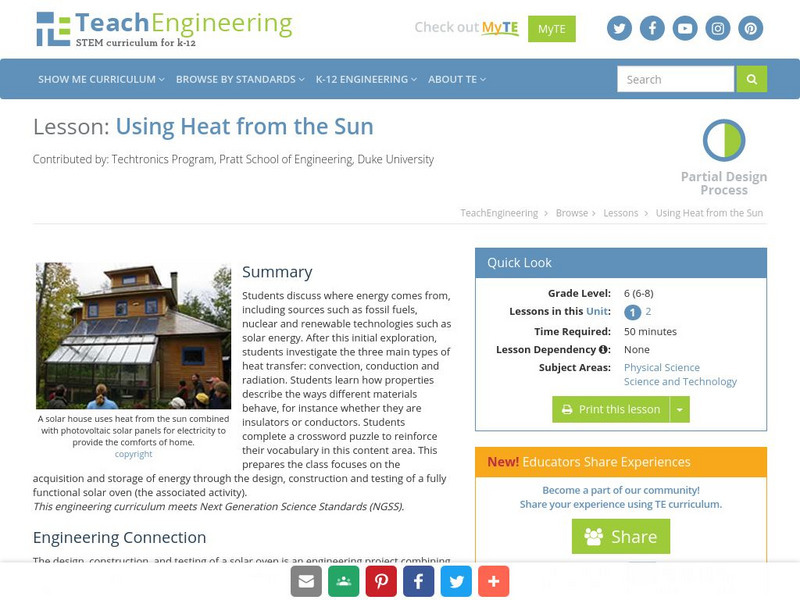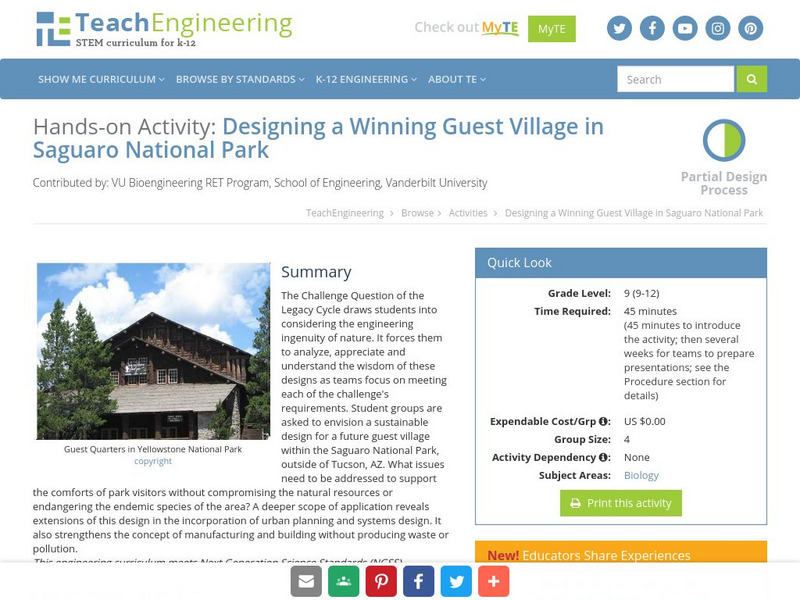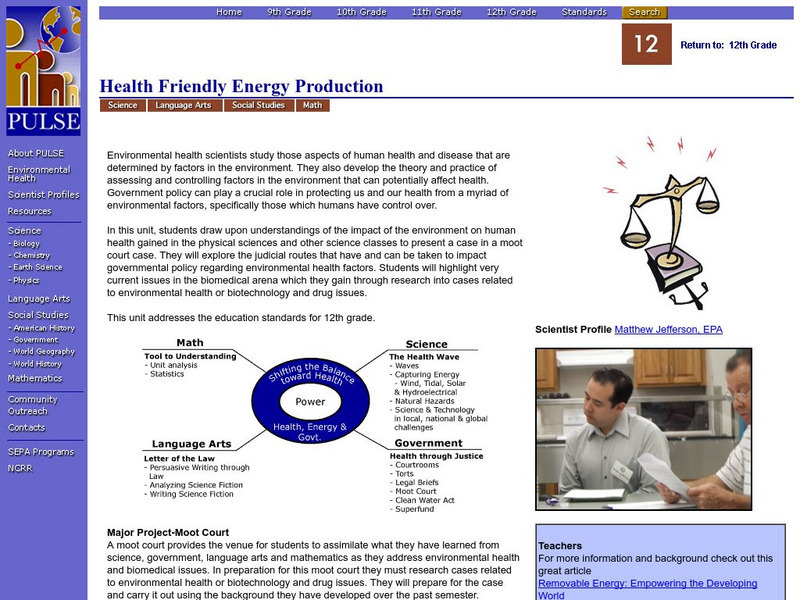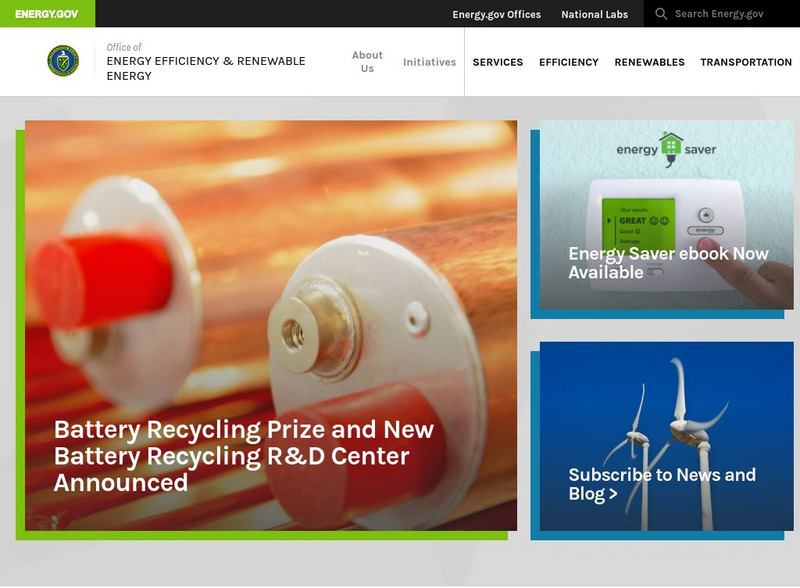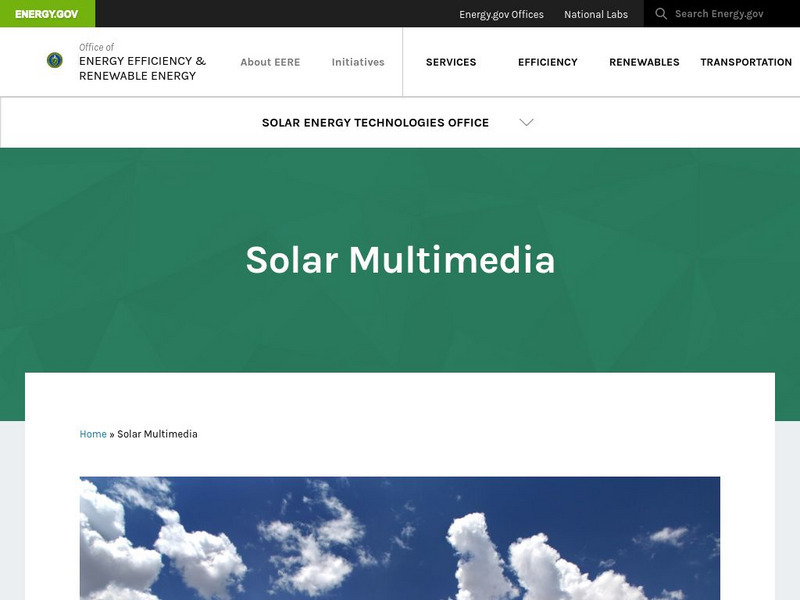TeachEngineering
Teach Engineering: Using Heat From the Sun
For this lesson, students will first discuss where energy comes from, including sources such as fossil fuels, nuclear, and such renewable technologies as solar. After this initial exploration, students will investigate the three main...
TeachEngineering
Teach Engineering: Designing a Winning Guest Village in the Saguaro National Park
The Challenge Question of the Legacy Cycle draws the student into considering the engineering ingenuity of nature. It will force him to analyze, appreciate and understand the wisdom of these designs as the student team focuses on meeting...
Other
U.s. Department of Energy: Photovoltaics
This site has an overview of PV technology, impact, system application and design. Information is provided on how to select the best solar system for various needs.
Science Education Resource Center at Carleton College
Serc: Lab 3: Discovering Local Data
An investigation that is part of a series of lab lessons that expose students to Earth Systems through research, data, and visulazations. This lab specifically has students using a database to gather and graph data to understand the role...
Science Education Resource Center at Carleton College
Serc: Lab 7: A Year in the Life of the Earth System
An investigation that is part of a series of lab lessons that expose students to Earth Systems through research, data, and visualizations. In this lab, students will observe how the Earth has changed over time to understand the Earth as...
University of Arizona
Pulse: Health Friendly Energy Production
A cross curricular project where students conduct a moot court to explore the role government policy plays in protecting our health. The focus of the unit is how our power effects our environmental health. Students use their knowledge of...
US Energy Information Administration
U.s. Eia Energy Kids: Energy Sources: Renewable
Find out what renewable energy is and the role it plays in meeting energy needs. Renewable energy sources include biomass, hydropower, geothermal, wind, and solar.
US Department of Energy
U.s. Department of Energy: Energy Efficiency and Renewable Energy
Access to information, policy initiatives, advice, and analysis on issues of energy efficiency and renewable energy, from the U.S. Department of Energy. Its network is responsible for tracking the technological, economic, and...
US Department of Energy
U.s. Department of Energy: Solar Energy Technologies Program: Solar Multimedia
Browse and download from this multimedia collection which contains photographs, videos, B-roll, graphics, and animations related to solar technologies, research, and projects.
Utah Education Network
Uen: Our Friend, the Sun
Understand the role of the sun as the source of heat and light for living things on earth.
Utah Education Network
Uen: Don't Marry the Mole!
Activities will demonstrate the power of solar energy.
NASA
Nasa: Solar Energy for Space Exploration
This activity book includes lessons and objectives for learners to explore solar energy for space exploration. Students will play an active part in decision making for space exploration.
State Energy Conservation Office-Texas
State Energy Conservation Office: Feasibility of Photovoltaic Systems [Pdf]
Summarizes how a photovoltaic or PV system works to convert solar energy into electricity. Explains how to estimate what size of PV system is needed and what the cost would be, and provides a worksheet with formulas for calculating...
Utah Education Network
Uen: Managing Heat
Understand the role of the sun as the source of heat and light for living things on earth.
Utah Education Network
Uen: Trb 4:1 Investigation 2 Why Does a Puddle Shrink?
Classroom activity helps students understand evaporation.
State Energy Conservation Office-Texas
State Energy Conservation Office: Learning About Photovoltaic Systems [Pdf]
Explains how photovoltaic systems work and how Texas homeowners are using them. Discusses how a homeowner can use solar energy and still be on the electricity grid system.
State Energy Conservation Office-Texas
State Energy Conservation Office: Passive Solar Design for Homes [Pdf]
Discusses different features that can be incorporated into a home's design in order to harness solar energy.
State Energy Conservation Office-Texas
State Energy Conservation Office: Cooking With the Sun [Pdf]
An introduction to solar cookers, how they are designed, and how to use one.
State Energy Conservation Office-Texas
State Energy Conservation Office: Solar Water Heaters [Pdf]
Explains the types of solar water heaters a home can have. These include a passive system, an active system, and a solar collector, as well as the need for a storage tank. It also gives tips on how to get the best use from a solar water...
State Energy Conservation Office-Texas
State Energy Conservation Office: Solar Electricity Works for Texas [Pdf]
Discusses photovoltaic energy systems and their many applications, e.g., in telecommunications, consumer products, space technology, solar lights, etc.
State Energy Conservation Office-Texas
State Energy Conservation Office: Solar and Electric Cars [Pdf]
Learn the differences between cars powered by different fuels. Looks at solar, electric, hybrid and gasoline-powered cars.
State Energy Conservation Office-Texas
State Energy Conservation Office: Electricity From the Sun [Pdf]
Discusses forms of renewable energy that rely on the sun. For example, wind is created when solar energy heats the air, and biomass is solar energy that has been stored in plants.
Other
Lincoln Public Schools: Applied Technology & Engineering: Solar Dragster Project [Pdf]
In this activity, students must design and build a solar-powered car that can complete a 20-meter racetrack (66 ft.) in the shortest amount of time over flat terrain. They learn about solar energy and car designs, and test their...
Concord Consortium
Concord Consortium: Stem Resources: Solar Oven
Use the sun's energy to cook an egg? Design, build and test a solar oven. Activity gives a procedure to build oven as well as questions to answer. Questions can be saved and graded by instructor.
